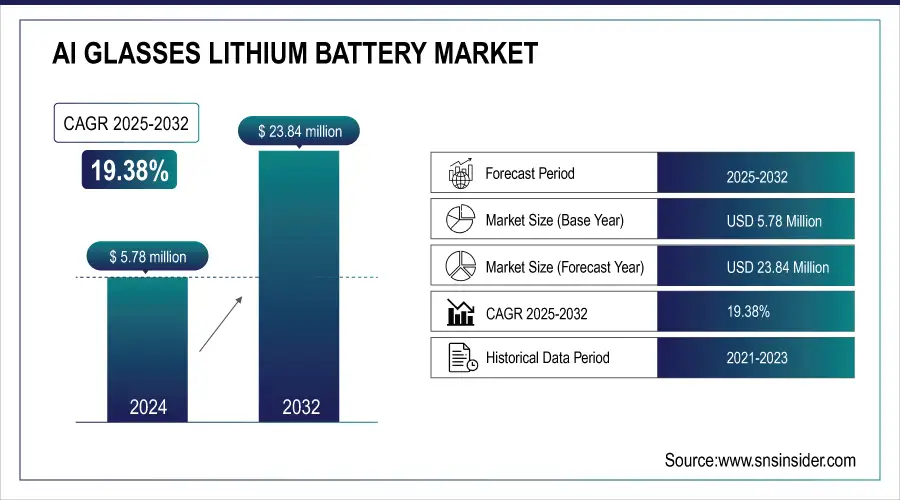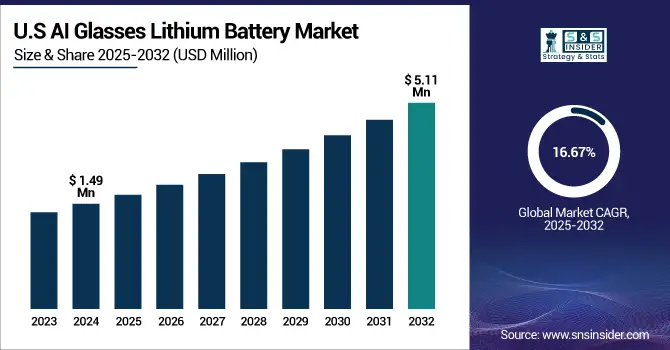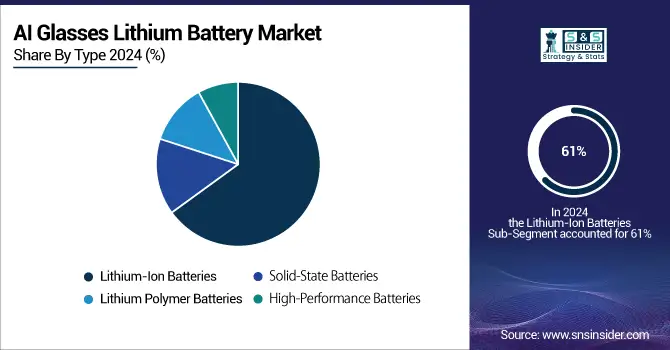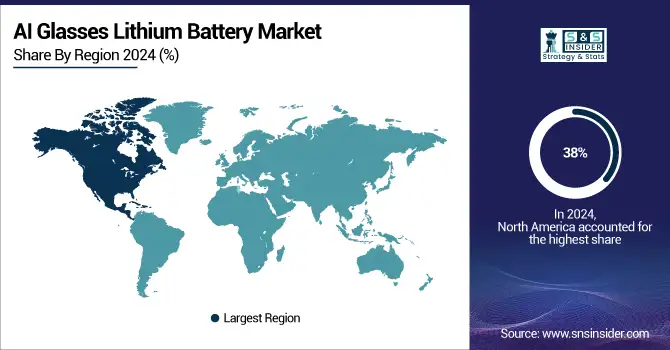AI Glasses Lithium Battery Market Size Analysis:
The AI Glasses Lithium Battery Market size was valued at USD 5.78 Million in 2024 and is projected to reach USD 23.84 Million by 2032, growing at a CAGR of 19.38% during 2025-2032.
The AI Glasses Lithium Battery market enables the increasing demand for ultra-compact, high-powered energy sources for wearable products. Such special batteries are utilized to empower AI functions, such as real-time translation, facial recognition and augmented reality, and need to be light, yet offer high energy density, long cycle life, and fast charging. Manufacturers are also increasing safety aspects, capacity, and durability with micro-lithium battery chemistries (solid-state and lithium-silicon). Battery design is also being driven by the move towards cobalt-free and sustainable materials. The lithium battery market is developing on the back of technology advancement, growing R&D investment, stringent regulations, and greater consumer attention to battery performance and lifespan as AI glasses feed into consumer electronics, healthcare, and enterprise.

To Get more information on AI Glasses Lithium Battery Market - Request Free Sample Report
For instance, realme GT 7 series launching May 27 features a 7,000 mAh lithium battery with 120W fast charging, achieving full charge in about 40 minutes. Their whitepaper with TUV Rheinland highlights lithium-ion limits and future tech including solid-state batteries, intelligent management, and advanced charging potentially benefiting AI glasses and wearables.
The U.S AI Glasses Lithium Battery market size was valued at USD 1.49 Million in 2024 and is projected to reach USD 5.11 Million by 2032, growing at a CAGR of 16.67% during 2025-2032, driven by rising adoption of wearable technology, increasing demand for advanced AR applications, and continuous innovation in battery efficiency and miniaturization. Supportive government initiatives and growing investments in smart consumer electronics further propel AI Glasses Lithium Battery market growth across industries such as healthcare, defense, and retail.

AI Glasses Lithium Battery Market Dynamics:
Drivers:
-
Integration of AI And Cost Optimization Drive Demand For AI Glasses Lithium Batteries
Expansion of artificial intelligence (AI) applications in multiple sectors is driving the growth of high-end lithium batteries in the AI glasses space. These wearables need high power density on-demand sources to power complex AI capabilities, such as real-time data processing, augmented reality, and always-on connectivity. On the technology side, the advancements of lithium battery technologies are facilitating longer battery life, faster charge time, and lightweight and small form-factor necessary for comfortable and sustainable AI glasses. The intersection of these two expanding AI application scenarios and evolvement of a better battery solution is spurring fast growth of the market and accelerating the AI glasses lithium battery Trends for worldwide adoption, indicating that lithium batteries are a key ingredient in the next smart wearables development.
Panasonic plans to cut costs and boost profits by over USD 966 million by 2027 through business overhaul and workforce restructuring. The company aims to expand AI integration across operations, collaborating with Anthropic to grow AI-related revenue, including AI data centers.
Restraints:
-
Safety Risks and High Costs Limit the Adoption of Lithium Batteries in AI Glasses
There are many problems that need to be solved for the popularization of lithium batteries in AI glasses. Safety issues that may arise due to high temperature and even on fire are still an important issue, especially for portable wearable devices, which demand small and light batteries. In addition, the high price of manufacturing and the materials used tend to raise the overall costs of AI glasses, which also makes it difficult to sell to many consumers.
Resources are scarce, and demand for rare metals, such as lithium and cobalt is a sustainable and supply chain risk. The battery life, charging speed and endurance of the devices are handicapped, and the user experience is significantly influenced. These factors combined make it difficult for manufacturers to develop a dependable, low-cost and safe lithium battery solution for the fast expanding AI glasses market.
Opportunities:
-
Enhanced Battery Performance and Charging Speeds Drive Growth in AI Glasses Market
The development of lithium batteries, such as higher energy density and much-improved charging time, provide strong chance of AI glasses’ development. The high energy density offers the possibility of longer operation per charge with less frequent recharges, good for wearables, such as AI glasses requiring flexible and lightweight power supply, and fast charging contributes to user convenience. When the product life of battery is prolonged, the frequent replacement would be largely reduced, the overall cost would be decreased, and the product would be more attractive. These innovation advancements make AI glasses to efficiently accommodate more sophisticated AI workloads, in addition to real-time data processing and augmented reality use cases. Therefore, these advancements are expected to drive faster adoption and increase the market size of AI glasses driven by the next-generation lithium batteries.
For instance, researchers from China and Germany have developed a new Li-S solid-state battery with a glass-like electrolyte that can charge in under one minute and lasts up to 25,000 cycles. This breakthrough promises up to three times the energy density of current lithium-ion batteries, potentially revolutionizing battery technology for the future.
Challenges:
-
Advanced AI Features Requiring Complex Integration Limit Battery Performance in AI Glasses
The increasing number of AI functions in smart glasses requires accurate combination of lithium battery and embedded electronic assembly. These gadgets require an efficient integration of power sources and sophisticated AI building blocks (processors, sensors, real-time databases). The problem is try and get the energy flow as constant as possible without sacrificing performance, weight or heat control. As AI, glasses become more powerful and begin to support more complex applications including real-time translation, object recognition, and immersive AR overlays, supplying a stable and efficient energy becomes challenging. The degree of integration requires high engineering and system optimization, and becomes a tough challenge for the manufacturers who are determined to offer AI glasses with lithium battery technology of lightweight, compact, and reliable performances.
AI Glasses Lithium Battery Market Segmentation Outlook:
By Type
The Lithium-Ion Batteries segment held a dominant AI Glasses Lithium Battery market share of around 61% in 2024. Lithium-ion batteries dominate the market for AI glasses lithium battery due to the attributes of high energy density, lightweight and long cycling life. These are essential to enable capabilities for advanced AI, such as real-time data and augmented reality, and therefore are the number one energy choice for wearable AI.
The Solid-State Batteries segment is expected to experience the fastest growth in the AI Glasses Lithium Battery market over 2025-2032 with CAGR 26.96%, as the Solid-State Batteries feature higher safety, energy density, and ultra-fast charging speed in the AI Glasses Lithium Battery market which is supporting their accelerated installations in the AI glasses. These benefits make them perfect for fueling small AI wearables, addressing consumer needs for extended battery life, lightweight, and better performance in the next-generation smart eyewear.

By Application
The Wearable Technology held an AI Glasses Lithium Battery market share of around 34% in 2024 owing to rising preference for wearable among the people, which in turn foster the demand for lithium battery in AI glasses. User's demands for wearable devices are higher, and they now prefer those, which are intelligent, real-time data processing and seamless access, and has long standby. This bi-directional trend is driving innovation for smaller, higher capacity lithium batteries, which are helping to power extended device-life and advanced features for AI eyewear.
The AI Glasses segment is projected to grow fastest in the AI Glasses Lithium Battery during 2025-2032, with a CAGR of 23.35%. AI glasses is a fast growing industry name in the industry due to consumers' increasing experience requirement of immersion and intelligent wear. AI-driven features including real-time translation, navigation, and facial recognition demand powerful, space-saving lithium batteries. The growing variety and popularity of AI glasses are driving the demand for efficient energy solutions, and increasing demand from the battery market.
AI Glasses Lithium Battery Market Regional Analysis:
In 2024, the North America dominated the AI Glasses Lithium Battery market and accounted for 38% of revenue share. North America's dominance in the AI Glasses Lithium Battery market is driven by strong technological infrastructure, high consumer adoption of advanced wearables, and significant investments in AI and battery innovation. The presence of key tech players and rising demand for smart wearable devices further fuel regional growth and battery advancements.

Get Customized Report as per Your Business Requirement - Enquiry Now
The U.S. leads the country in AI Glasses Lithium Battery market due to robust R&D investments, rapid AI adoption, and strong wearable tech demand.
Asia Pacific is projected to register the fastest CAGR of 21.55% during 2025-2032. The region’s growth can be attributed to the high adoption rate of wearable technology, growing consumer demand for AI-enabled devices, and significant investments in battery technology. Moreover, favorable government policies and increasing AI applications across the region are other vital factors propelling the market growth and contributing to the surging sales of AI glasses lithium batteries.
China dominates the Asia Pacific AI Glasses Lithium Battery market, driven by strong tech innovation and growing consumer demand.
In 2024, Europe emerged as a promising region in the AI Glasses Lithium Battery market in 2024 due to the growing investments on wearable technology coupled with the rising focus of sustainable energy solutions. Increasing consumer awareness and favorable government regulations also spur demand, promote product innovation, and advance market development in major European countries.
LATAM and MEA are experiencing steady growth in the AI Glasses Lithium Battery market due to growing usage of wearable devices and smart device infrastructure. Rising consumer base, increasing technology penetration, and favorable government interventions for digital connectivity in burgeoning economies is driving the market growth, which in fact has a potential outlook for the lithium battery manufacturers in these untapped regions.
Key Players in the AI Glasses Lithium Battery Market are:
The AI Glasses Lithium Battery market companies VARTA, LG Chem, Samsung SDI, BYD, Fullink Technology, Xuanli Electronics, Grepow Battery, CATL, EEMB, Desay Battery, and Others.
Recent Developments:
-
Jan 2025, Samsung Electro-Mechanics plans to mass-produce ultra-compact all-solid-state batteries for wearable devices by 2026, showcasing high energy density and glass substrate innovations. The company also aims to boost AI server sales with advanced silicon capacitors within the next two years.
-
Nov 2024, CATL is expanding beyond battery manufacturing into green energy solutions, aiming to develop and manage zero-carbon power grids for mines, cities, and data centers. With plans to launch a micro-grid pilot in the Democratic Republic of Congo in 2025 and an off-the-shelf EV platform to reduce automaker costs, CATL is positioning itself as a major player in sustainable energy infrastructure.
| Report Attributes | Details |
|---|---|
| Market Size in 2024 | USD 5.78 Million |
| Market Size by 2032 | USD 23.84 Million |
| CAGR | CAGR of 19.38% From 2025 to 2032 |
| Base Year | 2024 |
| Forecast Period | 2025-2032 |
| Historical Data | 2021-2023 |
| Report Scope & Coverage | Market Size, Segments Analysis, Competitive Landscape, Regional Analysis, DROC & SWOT Analysis, Forecast Outlook |
| Key Segments | • By Type (Lithium-Ion Batteries, Solid-State Batteries, Lithium Polymer Batteries and High-Performance Batteries) • By Application (AI Glasses, Wearable Technology, Smart Glasses, Consumer Electronics and AR/VR) |
| Regional Analysis/Coverage | North America (US, Canada, Mexico), Europe (Germany, France, UK, Italy, Spain, Poland, Turkey, Rest of Europe), Asia Pacific (China, India, Japan, South Korea, Singapore, Australia, Taiwan, Rest of Asia Pacific), Middle East & Africa (UAE, Saudi Arabia, Qatar, South Africa, Rest of Middle East & Africa), Latin America (Brazil, Argentina, Rest of Latin America) |
| Company Profiles | The AI Glasses Lithium Battery market companies VARTA, LG Chem, Samsung SDI, BYD, Fullink Technology, Xuanli Electronics, Grepow Battery, CATL, EEMB, Desay Battery and Others. |

